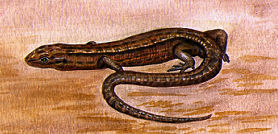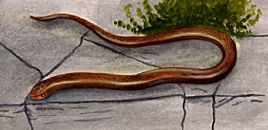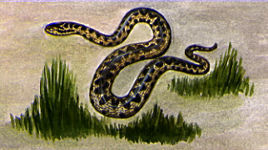Which Types of Reptiles Live in Britain?

Our native reptiles include three lizard and three snake species. The common or viviparous lizard is widespread in Britain, and occurs on mountain slopes, woodland glades, and waste ground (especially where spiders - its principal food -
are found). In contrast, the more brightly coloured sand lizard is found only in a few isolated localities in southern England with a remnant population in coastal Lancashire.
 The slow worm is a lizard which has evolved into a legless form with the development of a burrowing habit. Though widespread, it is seldom seen due to its burrowing and rather secretive habits. Although it favours dry country, it is found in a variety of moist micro-habitats in heathland, hedgerows and secluded country gardens.
The slow worm is a lizard which has evolved into a legless form with the development of a burrowing habit. Though widespread, it is seldom seen due to its burrowing and rather secretive habits. Although it favours dry country, it is found in a variety of moist micro-habitats in heathland, hedgerows and secluded country gardens.
 Of the three snakes, the smooth snake is the rarest, being found only in heathland and woodland areas of southern England. The grass snake is our largest snake and is widespread in England and Wales. It is more commonly found near water where it hunts amphibians and fish. The adder, our only venomous snake and also the most common, is found in woodland, moorland, and mountain slopes from Land's End to northernmost regions of Scotland.
Of the three snakes, the smooth snake is the rarest, being found only in heathland and woodland areas of southern England. The grass snake is our largest snake and is widespread in England and Wales. It is more commonly found near water where it hunts amphibians and fish. The adder, our only venomous snake and also the most common, is found in woodland, moorland, and mountain slopes from Land's End to northernmost regions of Scotland.
Credits
Image: Reptiles (British) by Thomas Brown
Why Does Britain Have so few Reptiles?
Both amphibians and reptiles are cold-blooded (ectothermic) animals. This means that they cannot regulate their body temperature without the warmth of the sun, they need to bask in sunlight, or on a warm rock in order to survive. The relatively cool climate and the fact that Britain is an island have contributed to the paucity of British amphibian and reptile fauna. The English Channel has been the main barrier to the invasion of these animals from continental Europe, which has over 80 species.
What is a Reptile?
Of the living groups of reptiles (tuatara, crocodilians, turtles, snakes and lizards) only snakes and lizards are represented in Britain. Unlike amphibians, reptiles have no larval forms. The young are either born alive (viviparous) like the adder and common lizard, or hatch from eggs (ovoviviparous) like the grass snake and sand lizard. Reptiles bodies are covered with scales, or bony plates (such as the shell of a tortoise). Lizards periodically shed their skins in flakes, while snakes cast off theirs as a single slough. They are cold blooded and need an external source of heat, such as the sun, to regulate their body temperature.

 The slow worm is a lizard which has evolved into a legless form with the development of a burrowing habit. Though widespread, it is seldom seen due to its burrowing and rather secretive habits. Although it favours dry country, it is found in a variety of moist micro-habitats in heathland, hedgerows and secluded country gardens.
The slow worm is a lizard which has evolved into a legless form with the development of a burrowing habit. Though widespread, it is seldom seen due to its burrowing and rather secretive habits. Although it favours dry country, it is found in a variety of moist micro-habitats in heathland, hedgerows and secluded country gardens. Of the three snakes, the smooth snake is the rarest, being found only in heathland and woodland areas of southern England. The grass snake is our largest snake and is widespread in England and Wales. It is more commonly found near water where it hunts amphibians and fish. The adder, our only venomous snake and also the most common, is found in woodland, moorland, and mountain slopes from Land's End to northernmost regions of Scotland.
Of the three snakes, the smooth snake is the rarest, being found only in heathland and woodland areas of southern England. The grass snake is our largest snake and is widespread in England and Wales. It is more commonly found near water where it hunts amphibians and fish. The adder, our only venomous snake and also the most common, is found in woodland, moorland, and mountain slopes from Land's End to northernmost regions of Scotland.
